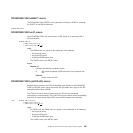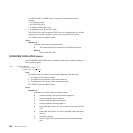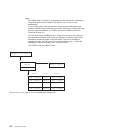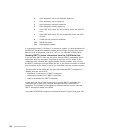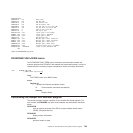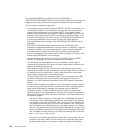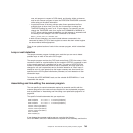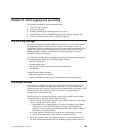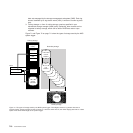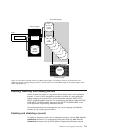The associated DSECTs are provided in member DFH$XRDS of
CICSTS32.CICS.SDFHSAMP. There are several ways in which you can change the
supplied code to make the overseer program more suitable for your installation.
Here are some customization suggestions:
v If the supplied display of status information (DSECT DSPDS) is not suitable, you
can change the layout for your installation. You may also want to change the
content of the status display if you are using DBCTL. The supplied sample
overseer program does not read the DBCTL-related information from the CAVM
data sets, and so cannot display DBCTL information on the MVS console. If you
want this to be displayed, you have to issue a DFHWOSM FUNC=READ macro
to retrieve the global data, and you have to change the status display to
accommodate the extra information. See “DFHWOSM FUNC=READ macro” on
page 699.
v The CSECT DFH$ADSP can be customized so that, for example, status
information is displayed automatically at regular intervals, or whenever a region is
in trouble, as well as when the console operator enters the Display command.
This would require interpretation of the status information by the overseer.
v Any of the messages to the system console, which are listed in the prolog of the
source module DFH$AXRO, can be changed.
v You can change the format or the content of the DFHOSD data set (DSECT
OSDDS) if, for example, you want it to contain more information.
v You can change the restart function so that, for example, a failed region is
restarted only during periods of heavy use, while at other times a takeover to the
alternate is initiated by the operator.
v When an active region fails and is taken over by the alternate, the old active
region must be restarted as the new alternate. In those cases where the cause of
the takeover was not an MVS failure, restart of the old active as an alternate
region could be automated in the overseer program.
v To extend the function of the overseer program, you can incorporate the CEBT
command, which is normally issued by the console operator to control the
alternate. The CEBT command is described in the CICS Supplied Transactions
manual.
All of the CEBT functions are available for use in the overseer program, though it
is unlikely that you will find it helpful to automate all of them, and there would, in
some cases, be difficulties in handling the responses from the INQUIRE
commands. However, it might be helpful for you to be able to automate the
takeover process in some circumstances. Here are two examples of situations in
which you could use the CEBT command to influence or to initiate takeover from
the overseer program:
– The active CICS may place error information in the CAVM data sets when a
VTAM failure occurs, depending on whether you have coded an exit program
at the global user exit point XXRSTAT, and, if so, how you have coded it. (An
exit program at this point can be used to decide whether or not VTAM failure
data is recorded in the CAVM data sets.) If such data is placed in the CAVM
data sets, information about the last eight failures detected by the active CICS
region is available to the overseer. The overseer can evaluate this information
and, if necessary, initiate a takeover by issuing the following CEBT command:
MODIFY jobname,CEBT PERFORM TAKEOVER
In this case, you should ensure that the actions taken by the global user exit
program at exit point XXRSTAT do not conflict with or duplicate those taken
by the overseer program. For example, it would be possible for the global
704 Customization Guide




